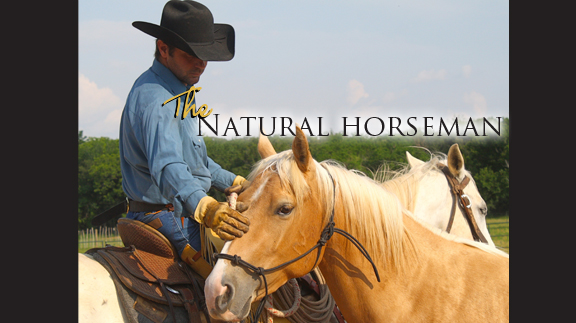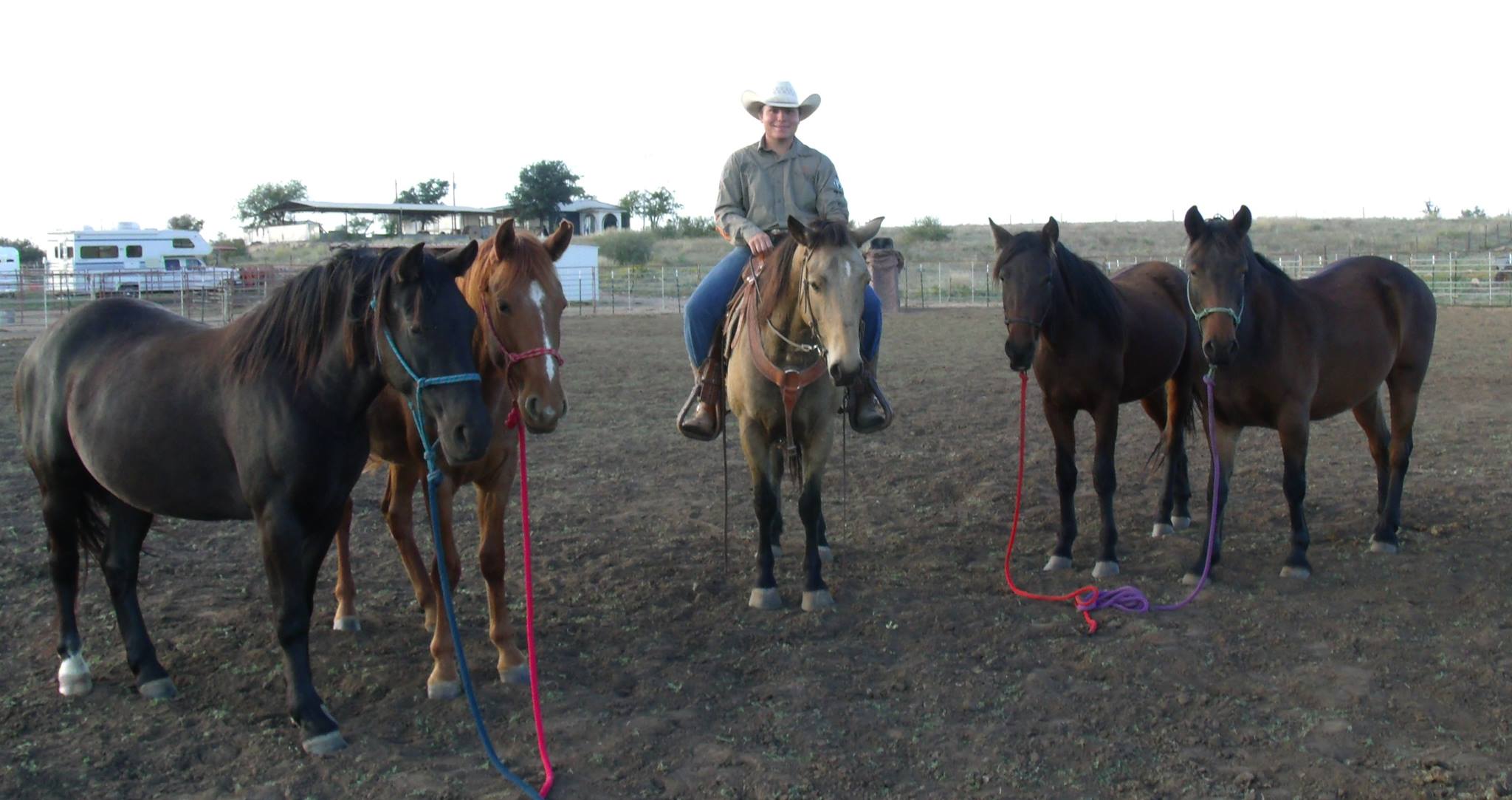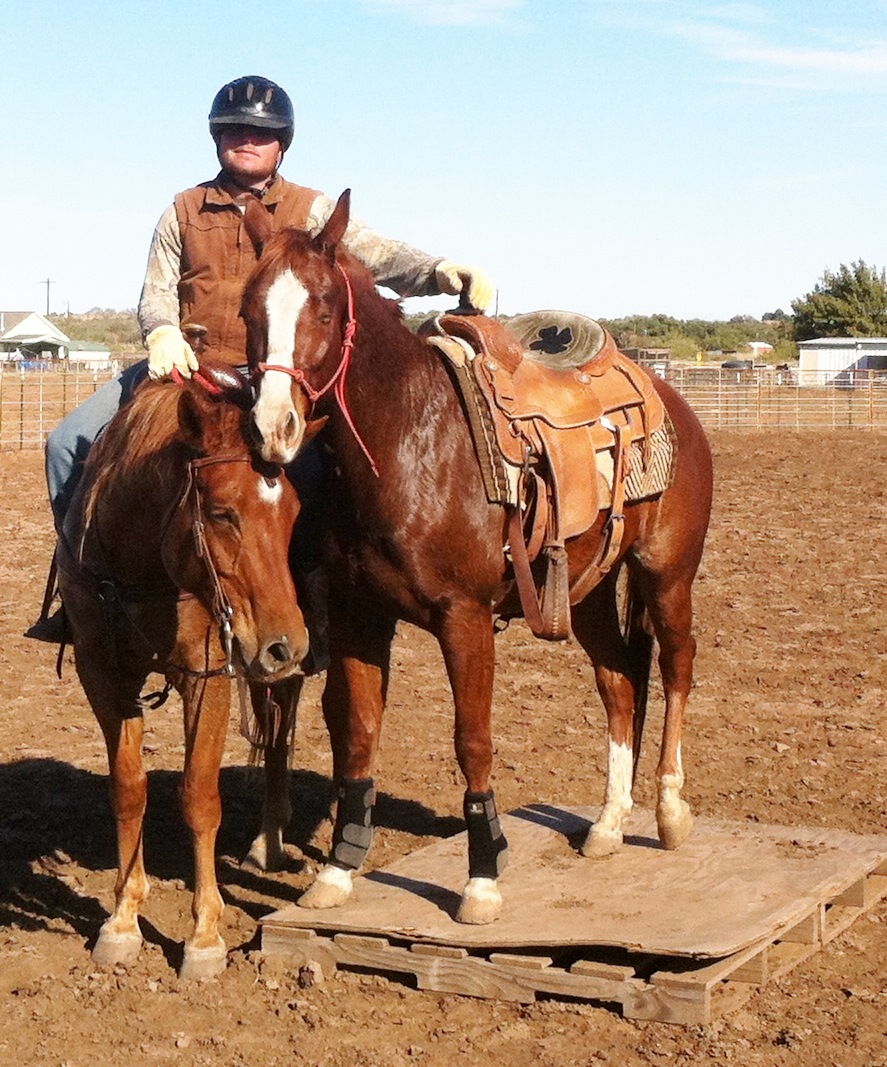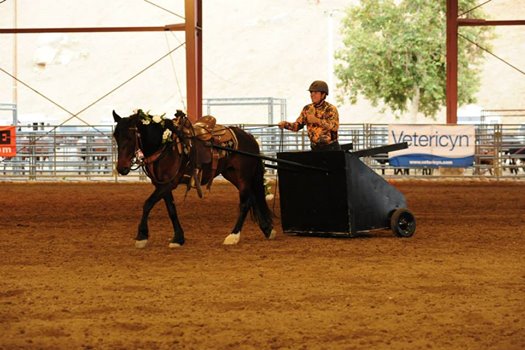HOME
The Natural Horseman – Don’t judge a book by its cover.

By Steve Stevens
Through adversity here comes the youth of horsemanship.
At three colt starting competitions, I have had the privilege to watch and compete with a young man by the name of Tyler Brewster.
Tyler Brewster. (Photo courtesy of Steve Stevens)
In Gainesville, Texas, Tyler showed up with a bright smile and a quiet disposition. Probably many would have considered him an underdog due to his youth at the age of twenty-one and the fact that there were at least three other competitors with multiple wins and years of experience under their belts. Tyler quietly won the competition showing a confident young horse like it had been ridden for months after only three and a half hours of handling. I was one of the doubters in the young man at first. I thought he just got lucky and that it would be tougher on him at the next competition.
I ran into him again about a month later. This time I made a conscious note to keep a closer eye on him. What I saw was a man who was determined to help the horse. He took his time, always seeming to be a step behind the rest of the group. With that being said, by the time we got into the obstacle finals round, he once again showed a quiet horse like he had been ridden for months. And once again Tyler won first in the competition with yours truly placing second.
I am sure the naysayers would say he drew two easy colts in a row, but I saw more than that. It was the way these colts carried themselves. They connected with him and moved for him with grace.
But once again I said to myself, “Maybe a fluke. We will see how he does at the last competition of the year.” We just competed at Abilene, Texas, this last weekend and Tyler did what he had done twice before, delivering a quiet well-moving colt, trotting over rails, dragging logs and cantering all around the giant Abilene arena. Tyler did not win the competition this time and ended up only two points shy of making the finals in Vegas.
But what I saw was more impressive than any buckles and finals qualifications, which was an unassuming man with a gentle and slow approach to horses, delivering one horse after another to owners with a great beginning foundation and most importantly, Tyler gives horses confidence in the human being and to me you can’t value that in gold buckles.
I have gotten to know Tyler over the last three competitions and have recently learned that there is more to his story.
Ever since Tyler was a little boy he wanted to be a horse trainer watching guys like Clinton Anderson and Chris Cox on TV. Tyler grew up in Van Horn, Texas. His mom rode while she was pregnant with him and got him in the saddle with her as soon as she could. His mom said he cried more than any baby she had ever seen but never cried when he was on a horse.
His family had a lease where they had a small cow/calf operation, where they grew hay in the summer and grazed 200 steers on wheat fields through the winter. 95 percent of the cattle work they did was on 4-wheelers and Tyler always wanted to use horses instead.
In April of 2006, Tyler was 13 years old.
In his own words, “We were gathering steers to ship them. I was on my Appaloosa barrel horse my parents bought me to do playdays on and we had the steers about half a mile from the pens. I turned my horse to push a steer that was moving slow and my horse spun around in the other direction and ran off. I tried to one rein stop him to the left but I couldn’t get him shut down. He was dead running towards a six wire fence.
“Mom and dad were on 4 wheelers and got in front of him and he still wouldn’t slow down or stop so Dad rode up beside me and grabbed my right rein and it pulled him off the 4-wheeler, and my horse fell down and slid. I shattered my right elbow into 20 pieces and killed skin and blood vessels in my right leg from upper thigh to below the knee. The impact even cracked my helmet.
“After many surgeries and many months of therapy on my arm, it is still froze up. I have skin grafts on my leg and I only have one layer of skin over my knee. After my wreck I swore I would never ride again…that lasted about a week. Then I was counting down the days to get back in the saddle.”
Tyler says that his wreck humbled him and made him a much better person; it helped to shape his horsemanship skills and to always put safety first.
Years later, Tyler has to navigate around his injuries when training, but I think it has helped him figure out how to connect with the horses on a deeper level.
What some people might consider an obstacle has truly become a blessing for the horse.
In 2008, Tyler’s father passed away from cancer after a two year battle. Tyler and his mother then moved to San Angelo to heal.
Tyler has competed in multiple competitions and has shown mustangs at the Extreme Mustang Makeovers, making the finals in all seven events he has entered. His best placings were third at Norco, Calif., in 2013, third at Mustang Magic Invitational at Ft. Worth in 2014 and Champion at Norco, Calif., in 2015.
Even more impressive than Tyler’s success is the true young gentleman that he is. Even after winning an event, he is the first person to help grab other contestants’ equipment and load it in their cars. It has been an honor to get to know Tyler and I would be truly blessed to have my own son grow up to become the man he is.
If this is any sign for the future of horsemanship, horses will have a bright future with their relationship with the human. I am proud to call Tyler my friend.
You can follow Tyler on Facebook as he continues to do competitions and trains horses for the public.
Attractions
The Deadliest Prairie in Texas

By Shannon Gillette
The Salt Creek Prairie with its rolling natural grasses and rampant wildflowers was a deceptive backdrop to the most dangerous prairie in Texas. Located in the northern section of Young County, the prairie absorbed an abundant amount of blood, shed from the battles between the encroaching white man and the Indians desperately trying to hold on to their home lands.
The Salt Creek Prairie was the location of several encounters between the Kiowa, Comanche and the area ranchers. The Indian Raid of Elm Creek on Oct. 13, 1867, resulted in the death of seven ranchers, five former Confederate Soldiers, the kidnapping of six women and children and the theft of 10,000 head of cattle. On May 18, 1871, the prairie witnessed another massacre when the Warren Wagon Train was hit by Kiowa under the command of Satanta, Satank and Big Tree. Seven members of the wagon train were murdered and forty-one mules stolen. But perhaps one of the bloodiest encounters was the Salt Creek fight on May 16, 1869.
Eleven cowboys under the watchful eye of their foreman, Captain Ira Graves were in the process of rounding up about five hundred head of their cattle about five miles southeast of present day Olney, Texas. The ranch hands were William Crow, John and George Lemley, C. L. Carter, Jason McClain, W. C. Kutch, J. W. Gray, Henry Harrison, Rube Secris, Joe Woody and a former slave known as Dick. They had noticed signs of recent Indian activity and were vigilant as they gathered the herd together. Each was armed with cap and ball six shooters. They had pointed the cattle towards the ranch and had made about four miles headway when they noticed a few more head grazing in the distance. Graves sent Carter and Kutch to gather them up. They had advanced about two miles when they spotted a large band of Indians approaching fast. Carter and Kutch could have taken cover in the sparse timber, but realized they would be leaving their companions in serious danger. The two groups met in the middle and tried to take cover in a small ravine that drained into the Salt Creek. The shallow-make shift fox hole offered very little protection.
The Indians attacked again and again. Arrows rained down on the cowboys in a continuous stream of painful blows. They attacked and retreated and attacked and retreated, but each time were met with volleys of gunfire from the small group of ranch hands. Each time the Indians retreated, they conferenced with their leader, who had stationed himself on a small hill away from the battle. After six hours of the constant onslaught, Graves developed a plan. When the Indians retreated, he ordered his men to stand and wave as wildly as they possibly could. The band of Indians, numbering over fifty strong, retreated for a final time, leaving the small band of cowboys alone.
As the dust settled the ranch hands evaluated their losses. In Kutch’s personal account given several years later, he described the aftermath: “Wm. Crow had been dead for several hours, and C. L. Carter had a severe arrow wound in his body, and had been also painfully injured with a rifle ball. John Lemley was mortally wounded in the abdomen with an arrow; J. W. Gray had been twice struck with rifle balls, once in the body and one in the leg; W. C. Kutch had two arrow heads in his knee and one in his shoulder; Jason McClain had been twice wounded with arrows; Rube Secris had his mouth badly torn, and his knee shattered; Geo Lemley had his face badly torn, and an arrow wound in his arm; and Ira Graves and Dick were also wounded.” Harrison was sent to Harmison Ranch for help.
The exhausted and wounded cowboys braved a very long and frightful night. With great relief, the morning hours brought the welcome sight of an incoming wagon. The rescuers patched the wounded as well as they could and sent word that doctors were needed desperately. The doctors did not arrive until a full twenty-four hours later. Carter passed away the next day from the injuries received during the battle. Two years later, McClain died while on another cattle drive. The cause of his death was blamed on the substantial injuries incurred on that fateful day in 1869.
While today the prairie grasses still wave and the wildflowers bloom in gorgeous arrays of colors nestled between cactus and mesquite, the blood shed is a distant memory. On crisp spring mornings it is easy to picture the deadly predicament that the cowboys faced.
This article originally appeared in the January 2016 issue of NTFR.
HOME
Preparing Spring Gardens

By Hannah Claxton | Editor
The North Texas area is located within USDA Hardiness zones seven and eight. The zones are categorized by predicted low temperatures for winter and timing of the first and last frosts.
Zone seven usually has winter low temps between 0 and 10 degrees F with the average date of the first frost falling between Oct. 29 and Nov. 15 and the average date of the last frost falling between March 22 and April 3.
Overall, these two zones have similar climates and growing conditions, making the options for timing and variety within a garden very similar.
In these zones, cool-season crops should go in the ground in March, meaning that soil preparation should start now.
To read more, pick up a copy of the January edition of North Texas Farm & Ranch magazine, available digitally and in print. To subscribe by mail, call 940-872-5922.

HOME
Equine Vaccinations

By Heather Lloyd
Vaccinations are a critical component of maintaining the health and well-being of horses, especially in environments where they are exposed to other animals, such as in the sport, show and performance arenas. Horses, like all animals, are susceptible to various infectious diseases that can spread quickly and cause serious harm.
A routine vaccination schedule helps prevent the spread of these diseases by preparing the horse’s immune system.
To read more, pick up a copy of the November edition of North Texas Farm & Ranch magazine, available digitally and in print. To subscribe by mail, call 940-872-5922.

-

 Country Lifestyles2 years ago
Country Lifestyles2 years agoScott & Stacey Schumacher: A Growth Mindset
-

 Country Lifestyles8 years ago
Country Lifestyles8 years agoStyle Your Profile – What your style cowboy hat says about you and new trends in 2017
-

 HOME8 years ago
HOME8 years agoGrazing North Texas – Wilman Lovegrass
-

 Outdoor10 years ago
Outdoor10 years agoButtercup or Primrose?
-

 Country Lifestyles9 years ago
Country Lifestyles9 years agoJune 2016 Profile – The man behind the mic: Bob Tallman
-

 Country Lifestyles8 years ago
Country Lifestyles8 years agoDecember 2016 Profile, Rusty Riddle – The Riddle Way
-

 Country Lifestyles5 years ago
Country Lifestyles5 years agoAmber Crawford, Breakaway Roper
-

 Horsefeathers11 years ago
Horsefeathers11 years agoMount Scott: Country Humor with David Gregory







